Greetings!
I figured that we've had seen the sun so far for 25 hours today, and just as we were gliding over the famous Golden Gate Bridge, it shone so brightly and beautifully. Plane flights are not such things to write home about, especially those that go on forever. Oslo to Frankfurt was a two-hour up and down over the cloud-filled Skaggerak Sea. Claiming our seats, we discovered that we had the window and the center of a three-seater row (Pat loves the aisle), so it didn't look like it would be a fun flight. Thankfully, the guy on the aisle (who could have benefited from some deodorant), wanted his own row, and moved shortly after takeoff. The Frankfurt airport was a hurried affair trying to get through the system of four separate passport checks while public address announcements of our flight leaving were being broadcast. Our seats on the 10 hour flight to San Francisco were on a big 777 aircraft, on a two-seat row right where I like them - left side, just in front of the wing. We filled the time watching four and a half full movies, of the quality you'd never go and see at the movies - but good enough to keep you from going crazy not having anything else to do. No dogs under the seat, no kids crying, just a long uneventful flight.
Missing the 8pm airport express home, we hung around the airport for 90 minutes people-watching and waiting for the 9:30pm bus. It came, we rode, and our friend Barbara picked us up from the stop it made, and drove us home. It's midnight, and Pat's opened the windows, turned the hot tub back on, and poured us a glass of wine. It was a great trip, but we're glad to be back in our bed. Neither of us has anything we need to do tomorrow, and we'll just enjoy the day at the house. One thing on my mind will be to start to re-organize one of the earlier posts on this blog which details our travel plans for the future. We did decide to go to South America this winter. We've got at least three possible one-month long adventures imagined down there but we haven't decided which one to do yet.
But now it's time for bed.
For many years, we've traveled to places around the world which intrigue us. Capturing photos, and always memories, this blog is our attempt to inspire others to pursue their dreams. Email us at gfearon@gmail.com.
Wednesday, August 8, 2007
Monday, August 6, 2007
Last Full Day in Norway
Greetings!
A couple of places on today’s itinerary (Historical Museum and the Doga Norwegian Centre for Architecture and Design) weren’t open. So we substituted a ferry boat tour around the Oslo Fjord.


But first, the Parliament (Stortinget). After a re-telling of Norway political history 101 by the tour guide, he led us into the central chambers of the Norwegian Parliament (Storting). Every four years, Norway’s voters elect (in19 geographical districts - counties) 169 members to the Storting. Using proportional representation of votes cast for parties within the districts, the party representation within districts is determined. The parties chose 169 members who assemble and constitute themselves about a week after the election. One quarter (42) of the members are elected to the Lagting. The remaining three-quarters (127) become members of the Odeling. Around 100-150 laws originate each year in the Odeling, are debated, passed, and sent to the Lagting. If approved by the Lagting, they are sent to the King for his Royal Assent and the Prime Minister for his signature. Of course, it’s much more complex if the law is the budget, or if the Odeling or the Lagting disagree on the content of the proposed law. But you get the point. Kind of like our system, but without the direct election of the legislative or executive branches.
I found three things of interest. First, the members can’t abstain from voting. It’s a yea or nay vote (green or red buttons at their chair). Second, they can’t comment from their chairs. The have to get recognized by the parliamentarian, wait their turn, and walk down to the main podium. Even if it’s a single question or comment. The physical exercise alone would make that a good idea, and it might even reduce the inane parliamentary bantering we have in the U.S. Finally, if the Lagting disapproves a law twice, the requirement for passage in the Odeling goes from a majority to two-thirds of the votes. In the U.S, we routinely send idiotic bills from the House of Representatives to the Senate – because we know the Senate will not pass them. It gives House members the ability to go back to their districts and blame the Senate. Lousy bills return each year, and the Senate kills them very predictably. This kind of rule would restrict that considerably. Of course, there’s also the fact that this system really turns the choice of political players over to the political parties. We don’t really have parties anymore, just players.
We then walked up into a neighborhood we’d read about Grunerlokka) which houses many of the new immigrants of Oslo. Near a central park, we had lunch at a bistro. Deciding to go back to the city center on a trolley, we talked with a young exchange student at the trolley stop who’d just returned from a stay in Santa Cruz.
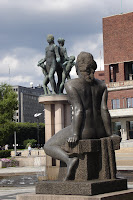
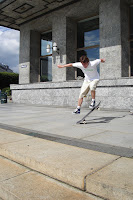
Out in front of the city hall, we bought tickets to the 2-hour boat tour beginning in 90 minutes, and passed the time people-watching from a bench in the large plaza. The boat tour was pleasant, but not so full of the city sites. Mostly, the surrounding islands and peninsulas full of summer cabins and all kinds of pleasure boats. Afterward, we walked back to our hotel, pausing for dinner at a Dolly Dimple (a chain we’d seen since Lillehammer that intrigued us). On the final stretch home, we checked out our train connection to the airport tomorrow morning.


Another trip would include: 1) more of Sweden and especially Gotland; 2) far north of Norway; and 3) probably Iceland.
Here is a link to all of the photos we took today: Last Day
A couple of places on today’s itinerary (Historical Museum and the Doga Norwegian Centre for Architecture and Design) weren’t open. So we substituted a ferry boat tour around the Oslo Fjord.
But first, the Parliament (Stortinget). After a re-telling of Norway political history 101 by the tour guide, he led us into the central chambers of the Norwegian Parliament (Storting). Every four years, Norway’s voters elect (in19 geographical districts - counties) 169 members to the Storting. Using proportional representation of votes cast for parties within the districts, the party representation within districts is determined. The parties chose 169 members who assemble and constitute themselves about a week after the election. One quarter (42) of the members are elected to the Lagting. The remaining three-quarters (127) become members of the Odeling. Around 100-150 laws originate each year in the Odeling, are debated, passed, and sent to the Lagting. If approved by the Lagting, they are sent to the King for his Royal Assent and the Prime Minister for his signature. Of course, it’s much more complex if the law is the budget, or if the Odeling or the Lagting disagree on the content of the proposed law. But you get the point. Kind of like our system, but without the direct election of the legislative or executive branches.
I found three things of interest. First, the members can’t abstain from voting. It’s a yea or nay vote (green or red buttons at their chair). Second, they can’t comment from their chairs. The have to get recognized by the parliamentarian, wait their turn, and walk down to the main podium. Even if it’s a single question or comment. The physical exercise alone would make that a good idea, and it might even reduce the inane parliamentary bantering we have in the U.S. Finally, if the Lagting disapproves a law twice, the requirement for passage in the Odeling goes from a majority to two-thirds of the votes. In the U.S, we routinely send idiotic bills from the House of Representatives to the Senate – because we know the Senate will not pass them. It gives House members the ability to go back to their districts and blame the Senate. Lousy bills return each year, and the Senate kills them very predictably. This kind of rule would restrict that considerably. Of course, there’s also the fact that this system really turns the choice of political players over to the political parties. We don’t really have parties anymore, just players.
We then walked up into a neighborhood we’d read about Grunerlokka) which houses many of the new immigrants of Oslo. Near a central park, we had lunch at a bistro. Deciding to go back to the city center on a trolley, we talked with a young exchange student at the trolley stop who’d just returned from a stay in Santa Cruz.
Out in front of the city hall, we bought tickets to the 2-hour boat tour beginning in 90 minutes, and passed the time people-watching from a bench in the large plaza. The boat tour was pleasant, but not so full of the city sites. Mostly, the surrounding islands and peninsulas full of summer cabins and all kinds of pleasure boats. Afterward, we walked back to our hotel, pausing for dinner at a Dolly Dimple (a chain we’d seen since Lillehammer that intrigued us). On the final stretch home, we checked out our train connection to the airport tomorrow morning.
Another trip would include: 1) more of Sweden and especially Gotland; 2) far north of Norway; and 3) probably Iceland.
Here is a link to all of the photos we took today: Last Day
Sunday, August 5, 2007
Vigeland Sculpture Garden
Greetings!
We had a couple of hours with nothing planned this morning, as the first place we were scheduled to see didn't open until noon. We decided to spend it near our hotel at some of the stores. It turns out that almost nothing was open on Sunday morning in central Oslo. I suspect that it had something to do with the fact that today is the final day of the biggest football (soccer) match in the world, being held here in Oslo (Norway Cup). We've been seeing lots of organized groups of teenagers in the streets in the past few days, all looking like they are having the fun of a lifetime.

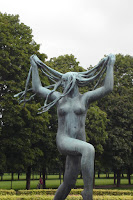
So we changed our itinerary, and took the trolley to the Vigeland Sculpture Park, originally scheduled for tomorrow. Gustav Vigeland's 200 sculptures line the main avenue of the beautiful park named in his honor. Gardens and fountains also abound, but it is his lifesize, life-like characters that gather photographers. I especially liked the four granite columns combining dragons and humans, but was awed by the 16 pieces surrounding the largest column (the Monolith). It's a linear museum walk you won't forget.


We left the park, and traveled across town by trolley to our 12 o'clock destination - The Norwegian Museum of Cultural History. Disaapointment met us when we arrived and found that they were closed until October, presenting only a small gallery of art, and an apologetic receptionist. Next, a walkup the hill to another large park where the University of Oslo Natural History Museum is located.
Now I can spend days in most natural history museums. But lately, I've been hampered by a desire to focus almost exclusively on the search for additional specimens of a rare old fish that I own (Dipnoi - 350 million years old, and a cousin of the creature which carried fish to mammals). Like a crazed hunter, I wandered quickly through really interesting rooms full of great displays of all kinds of rocks and fossils and creatures. Finally, I got to announce to Pat (who knows when I get this fanatic) that the specimen housed here was yet another poor second to my great prize. The search for a clearer and more interesting-looking fossil continues withmany more museums to search out. I do hope that I can learn to like looking at other things in these wonderful collections again.

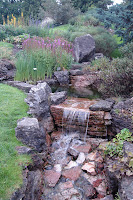
The walk across the park to the Edward Munch Museum led us to an well-designed stream with waterfalls and plants. Larger than ours, but not any prettier.
I had heard about the burglary which took place recently when a young man stole Edward Munch's most famous painting (The Scream) in broad daylight from the Museum. It has been recovered, but is still being repaired. The Museum is displaying an earlier drawing of the scene. It appears that its directors have decided to go overboard to send the message that they won't let it happen again. There are plenty of airports with less security than is now in place here. Interestingly, Pat found that her swiss army knife went through just fine. They must not care if you go in and destroy the paintings, just don't take any of them.
Before today, I probably could not have named the artist who painted "The Scream", but I certainly knew of it. I could not have identified any of his other works. The Munch (pronounced Monk) Museum holds 1,100 paintings, 4,500 drawings,and 18,000 prints depicting the works of a tormented life of a damaged, lonely artist supported by others who hoped he'd someday make good. Amazingly, he did, becoming quite wealthy in his latr years from the sale of paintings illustrating himself, his nude models, and five conditions: fear, anger, jealousy, attraction, and grief. After seeing the displayed collection, I think I could identify a painting of his, but I couldn't describe more than a few. There's just too many of the same themes, and his expressionistic style (excuse me) screams out for a little more restraint. I felt like I was in a photographer's studio where he was displaying every photo he ever took. But I guess that's the thing with painters, every one attempt matters.
We came back to the hotel, rested, and went to dinner down by the docks. What could have been a really great dinner was marred by a really poor plate of scampi for Pat. I had a great arctic trout, stuffed with spinach and scallops, asparagus, cheese and potato side dish, house salad, and a nice white wine from France.
Tomorrow, we round out the Oslo stay with a tour of the Parliament in the morning, the Historical Museum in the early afternoon, and perhaps the Doga Norwegian Center for Architecture and Design.
Here is a link to all of the photos we took today: Vigeland Sculpture Park
We had a couple of hours with nothing planned this morning, as the first place we were scheduled to see didn't open until noon. We decided to spend it near our hotel at some of the stores. It turns out that almost nothing was open on Sunday morning in central Oslo. I suspect that it had something to do with the fact that today is the final day of the biggest football (soccer) match in the world, being held here in Oslo (Norway Cup). We've been seeing lots of organized groups of teenagers in the streets in the past few days, all looking like they are having the fun of a lifetime.
So we changed our itinerary, and took the trolley to the Vigeland Sculpture Park, originally scheduled for tomorrow. Gustav Vigeland's 200 sculptures line the main avenue of the beautiful park named in his honor. Gardens and fountains also abound, but it is his lifesize, life-like characters that gather photographers. I especially liked the four granite columns combining dragons and humans, but was awed by the 16 pieces surrounding the largest column (the Monolith). It's a linear museum walk you won't forget.
We left the park, and traveled across town by trolley to our 12 o'clock destination - The Norwegian Museum of Cultural History. Disaapointment met us when we arrived and found that they were closed until October, presenting only a small gallery of art, and an apologetic receptionist. Next, a walkup the hill to another large park where the University of Oslo Natural History Museum is located.
Now I can spend days in most natural history museums. But lately, I've been hampered by a desire to focus almost exclusively on the search for additional specimens of a rare old fish that I own (Dipnoi - 350 million years old, and a cousin of the creature which carried fish to mammals). Like a crazed hunter, I wandered quickly through really interesting rooms full of great displays of all kinds of rocks and fossils and creatures. Finally, I got to announce to Pat (who knows when I get this fanatic) that the specimen housed here was yet another poor second to my great prize. The search for a clearer and more interesting-looking fossil continues withmany more museums to search out. I do hope that I can learn to like looking at other things in these wonderful collections again.
The walk across the park to the Edward Munch Museum led us to an well-designed stream with waterfalls and plants. Larger than ours, but not any prettier.
I had heard about the burglary which took place recently when a young man stole Edward Munch's most famous painting (The Scream) in broad daylight from the Museum. It has been recovered, but is still being repaired. The Museum is displaying an earlier drawing of the scene. It appears that its directors have decided to go overboard to send the message that they won't let it happen again. There are plenty of airports with less security than is now in place here. Interestingly, Pat found that her swiss army knife went through just fine. They must not care if you go in and destroy the paintings, just don't take any of them.
Before today, I probably could not have named the artist who painted "The Scream", but I certainly knew of it. I could not have identified any of his other works. The Munch (pronounced Monk) Museum holds 1,100 paintings, 4,500 drawings,and 18,000 prints depicting the works of a tormented life of a damaged, lonely artist supported by others who hoped he'd someday make good. Amazingly, he did, becoming quite wealthy in his latr years from the sale of paintings illustrating himself, his nude models, and five conditions: fear, anger, jealousy, attraction, and grief. After seeing the displayed collection, I think I could identify a painting of his, but I couldn't describe more than a few. There's just too many of the same themes, and his expressionistic style (excuse me) screams out for a little more restraint. I felt like I was in a photographer's studio where he was displaying every photo he ever took. But I guess that's the thing with painters, every one attempt matters.
We came back to the hotel, rested, and went to dinner down by the docks. What could have been a really great dinner was marred by a really poor plate of scampi for Pat. I had a great arctic trout, stuffed with spinach and scallops, asparagus, cheese and potato side dish, house salad, and a nice white wine from France.
Tomorrow, we round out the Oslo stay with a tour of the Parliament in the morning, the Historical Museum in the early afternoon, and perhaps the Doga Norwegian Center for Architecture and Design.
Here is a link to all of the photos we took today: Vigeland Sculpture Park
Saturday, August 4, 2007
Bygdoy
Greetings!
More Norwegian history - Viking ships and Samis. We found our way to the city's ferry docks, after scouting out the route we need to take with our bags on Tuesday to get to the airport. We've made it a habit of knowing beforehand, due to one-too-many frantic rushes on a day when you can't be late.
The ferry to the Bygdoy Peninsula carries 75 passengers in seats, and it was jammed packed today. We stood for the short ride, and once again got away with caling me a senior. As my beard gets longer and whiter on these trips, It sure does save money. That, and the student ID's from Sonoma State Osher Lifelong Learning Institute. There are five excellent attractions on Bygdoy, a park amidst a rich, older home area. Not unlike what we have in the U.S., it has become a favorite place for many to spend the day.



We chose to go to the Viking Ship Museum and the Norwegian Museum of Cultural History. I am so glad that we went to the Viking Ship Museum at this time in our trip. At the previous places where we learned about Viking shipbuilding, or about life in the era which is referred to as the Viking period, the information was exciting but not nearly as complete as it is here. The earlier materials provided us glimpses, and it stimulated our thinking well. Each new fact filled in more of the story. This museum adds another large piece, and does it with overwhelming visual clarity. It also places the other information in the larger context by an excellent use of its wall panels. The main stars of the collection are the display of three large burial ships, and hundreds of very impressive sledges,carts, cooking pots, ceremonial staffs, and other gear which accompanied the dead.

In one boat, an important older woman and her maid servant were accompanied to Valhalla with a carriage, dead horses with saddles and bridles, and even furniture. In the fourth wing of the museum, more of the materials which were in the burials is displayed. In a level above the ships, panels tell the story of the discovery and salvaging of these unique and important ships.
Seeing these huge ships, and marveling at the detail with which they carved figures and images on the bow and stern prows, one can only imagine the terror felt by those upon whose shores they landed. I was also impressed with the precision with which they crafted these sailing vessels, of oak and iron, powerful yet light enough to carry when needed. There are nine reconstructed Viking ships in the world, and we have now seen eight of them. I think I have a pretty good beginning with which to continue to pursue my research into lives of some of my ancestors from 800AD to 1066AD. The last ship is in a county museum quite a ways out of our travel path, and it will remain the elusive one.

The Norwegian Museum of Cultural History provided an enormous treasure of displayed buildings, clothing, music, customs (modeled by local enactors) from the last 300 years. The photo to the left shows me in front of a house reputed to be from my ancestral home town (Vang).

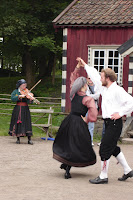
We were also treated to the dance and music of Norway's past by a couple of young people who were there to tell us about the marriage ceremonies of an earlier day. It just so happened that the resident Stave church was being used for a marriage at the time we were there.
But the Center's unique new contribution to us was the amount of information in displayed about Norway in the last 50 years. Hardly anyone thinks of recent history as worthy of including in a museum, but it's essential info in order to grasp the complete story of what we see around us as we travel through the country. We spent extra time in the areas of the open air museum where the social, political, cultural,and economic dynamics in the country from 1950 til now was described in detail. We thought of Ola, Gerd Marie, Helga, and Anna Ragnhild, and how each might have been impacted.
The Museum also had a special exhibit on the Sami population in Northern Norway. We have seen other sections of other museums devote space to the Samis, but this one far exceeded any that we had seen. The clothing was more varied, the art went beyond ivory carvings, and the video they showed was one of the best descriptions of any culture I have ever seen. A very welcome addition to it was the time it devoted to the social awakening in the country as a result of an oil drilling proposal on Sami land decades ago. The arrests of supporters, sit-ins at Parliament, and hunger stikes were all employed to bring a new consciousness to the political arena. The video contained powerful interviews with present-day Samis who continue to fight to retain their languages, their culture, and their individuality. The similarity between their committment to the struggle, and that of other indigenous peoples we have visited, was remarkable and inspiring.
Tomorrow, we travel across town to the International Culture Center and Museum, the Museum of Natural History, and the Munch Museum. We're interested in the first because we hope to learn more about present day Norway, and of immigration and cultural changes in the society. All around us as we travel in the capitol, we see the faces and hear the voices of a different mix of people than in the rural areas of the country. We'd like to know more about what the country says about that. The Museum of Natural History is my always favorite place to learn about a country: its geology, archealogy, zoology, and all old living things. Finally, Edward Munch is a prolific and unique expressionist painter whose works have appeared in many other museums we've visited on this trip. We thought it would be nice to see his home collection.
Here is a link to all of the photos we took today: Bygdoy
More Norwegian history - Viking ships and Samis. We found our way to the city's ferry docks, after scouting out the route we need to take with our bags on Tuesday to get to the airport. We've made it a habit of knowing beforehand, due to one-too-many frantic rushes on a day when you can't be late.
The ferry to the Bygdoy Peninsula carries 75 passengers in seats, and it was jammed packed today. We stood for the short ride, and once again got away with caling me a senior. As my beard gets longer and whiter on these trips, It sure does save money. That, and the student ID's from Sonoma State Osher Lifelong Learning Institute. There are five excellent attractions on Bygdoy, a park amidst a rich, older home area. Not unlike what we have in the U.S., it has become a favorite place for many to spend the day.
We chose to go to the Viking Ship Museum and the Norwegian Museum of Cultural History. I am so glad that we went to the Viking Ship Museum at this time in our trip. At the previous places where we learned about Viking shipbuilding, or about life in the era which is referred to as the Viking period, the information was exciting but not nearly as complete as it is here. The earlier materials provided us glimpses, and it stimulated our thinking well. Each new fact filled in more of the story. This museum adds another large piece, and does it with overwhelming visual clarity. It also places the other information in the larger context by an excellent use of its wall panels. The main stars of the collection are the display of three large burial ships, and hundreds of very impressive sledges,carts, cooking pots, ceremonial staffs, and other gear which accompanied the dead.
In one boat, an important older woman and her maid servant were accompanied to Valhalla with a carriage, dead horses with saddles and bridles, and even furniture. In the fourth wing of the museum, more of the materials which were in the burials is displayed. In a level above the ships, panels tell the story of the discovery and salvaging of these unique and important ships.
Seeing these huge ships, and marveling at the detail with which they carved figures and images on the bow and stern prows, one can only imagine the terror felt by those upon whose shores they landed. I was also impressed with the precision with which they crafted these sailing vessels, of oak and iron, powerful yet light enough to carry when needed. There are nine reconstructed Viking ships in the world, and we have now seen eight of them. I think I have a pretty good beginning with which to continue to pursue my research into lives of some of my ancestors from 800AD to 1066AD. The last ship is in a county museum quite a ways out of our travel path, and it will remain the elusive one.
The Norwegian Museum of Cultural History provided an enormous treasure of displayed buildings, clothing, music, customs (modeled by local enactors) from the last 300 years. The photo to the left shows me in front of a house reputed to be from my ancestral home town (Vang).
We were also treated to the dance and music of Norway's past by a couple of young people who were there to tell us about the marriage ceremonies of an earlier day. It just so happened that the resident Stave church was being used for a marriage at the time we were there.
But the Center's unique new contribution to us was the amount of information in displayed about Norway in the last 50 years. Hardly anyone thinks of recent history as worthy of including in a museum, but it's essential info in order to grasp the complete story of what we see around us as we travel through the country. We spent extra time in the areas of the open air museum where the social, political, cultural,and economic dynamics in the country from 1950 til now was described in detail. We thought of Ola, Gerd Marie, Helga, and Anna Ragnhild, and how each might have been impacted.
The Museum also had a special exhibit on the Sami population in Northern Norway. We have seen other sections of other museums devote space to the Samis, but this one far exceeded any that we had seen. The clothing was more varied, the art went beyond ivory carvings, and the video they showed was one of the best descriptions of any culture I have ever seen. A very welcome addition to it was the time it devoted to the social awakening in the country as a result of an oil drilling proposal on Sami land decades ago. The arrests of supporters, sit-ins at Parliament, and hunger stikes were all employed to bring a new consciousness to the political arena. The video contained powerful interviews with present-day Samis who continue to fight to retain their languages, their culture, and their individuality. The similarity between their committment to the struggle, and that of other indigenous peoples we have visited, was remarkable and inspiring.
Tomorrow, we travel across town to the International Culture Center and Museum, the Museum of Natural History, and the Munch Museum. We're interested in the first because we hope to learn more about present day Norway, and of immigration and cultural changes in the society. All around us as we travel in the capitol, we see the faces and hear the voices of a different mix of people than in the rural areas of the country. We'd like to know more about what the country says about that. The Museum of Natural History is my always favorite place to learn about a country: its geology, archealogy, zoology, and all old living things. Finally, Edward Munch is a prolific and unique expressionist painter whose works have appeared in many other museums we've visited on this trip. We thought it would be nice to see his home collection.
Here is a link to all of the photos we took today: Bygdoy
Friday, August 3, 2007
Oslo by Bus
Greetings!
Today, we watched Norway go by the bus window for 10 hours. While the scenery was reminiscent, and felt somewhat like the feeling we get when we are leaving a city and have it pretty much figured out, it also reaffirmed how really great this country is. We didn't take any pictures (nothing like smudged windows, and jerky camera movement, to spoil the beauty). But I am including an earlier shot, taken from the top of a hill, which I took with Ola standing nearby. I think I'll remember this scene for a long time.
For the next three days, we'll see Oslo. This evening, we started it off at a great Indian restaurant (Jaipur region). Nothing like good chicken curry, with raisins, bell peppers, and cashews.
Thursday, August 2, 2007
Geiranger
Greetings!
(From Pat's Journal)
We decided to take the 8hr fjord trip after all on the bet that we'd really kick ourselves to learn "these" fjord were really spectacular, and we'd passed them by. AND WE ARE SO GLAD WE DID. We met our charming young guide, Alexander, while waiting for the ticket office to open - joking with him that we'd seen New Zealand fjords, and had pretty high standards to be impressed! We started off on a bus with about 15 others: 2 Dutch, 2 German, 2 Norwegian, 1 Slovenian, and those rowdy 5 Spanish folks that were on our Bergen - Alesund trip(!). The bus took us about 45 minutes to a short (10 minute) ferry hop across a fjord, then another bus leg to a big fjord ferry along the "urinefjord" or Hjorundfjord as the Norwegians spell it, for about 90 minutes of splendor.
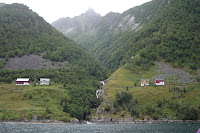
There are hamlets (30-50-100) all along the way, and isolated farms at every feasible (and nearly unfeasible) spots. They are all now linked by ferry, and have tv, phone, and internet. Many have roads in between them - but not all. Many had electricity starting in the 20's with hydro power from the many rivers and waterfalls. In the winter, these roads are not maintained - so they rely on ferries. Many families fish (not season now, so we didn't see this) or work somehow in the oil industry with two weeks on, two weeks off schedules. Our guide says with access the bigger villages are actually growing in size since the 60's. One has to think about how hard life must have been 100+ years ago when people were really isolated 5+months of the year (when the days were 4-6 hours long!).

There were many, many ragged high peaks of the Sunnmore Alpson either side of the fjord, but no porpoises. We huddled up top ship to take it all in - it wasn't cold, so much as windy. We came to shore at Hellesylt, and stopped at the Union Hotel - a victorian hotel all swiss gingerbread to see where Kaiser Wilhelm of Germany and English nobility/mountaineers held up between roughing it on yachts and mountaineering.


The rooms had names of famous guests on the doors, including Grieg, Ibsen, the Queen (of Norway), and the Kaiser. A short way on, we stopped at a museum center for a quick but lovely lunch plate of lox, prawn, lamb salami, prociuto, a soft cheese, potato salad, topped off with apple cake with a huge dollop of whipped cream and coffee. The museum housed an incredible collection of 13 hand-carved wood panel reliefs depicting the story of Peer Gynt from the Ibsen play. Our guide quickly narrated the story in English and Norwegian. He was in a hurry to meet our next ferry, and the tale is long and tedious, and the panels a bit disjointed - so I don't think any of us really got the gist of the tale (which brings me back to my brother Ken's stage managing Peer Gynt at Solvang which I also managed to shiver and sleep through).
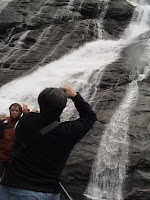
Back on the road to Leknes where we board a smaller 62 Degrees Nord boat to do the famous Geirangerfjord (on the UNESCO World Heritage list). This is a much narrower and shorter fjord (about 16kms long), so the trip is just 40 minutes. Although the sky is quite threatening now, we brave the top level for the shorter trip. This fjord has several magnificent waterfalls - the first we've seen that are actually named, e.g. Seven Sisters, the Suitor, etc. Unbelievably, there are farms perched precariously on the steep sides of the fjord near them. The last was abandoned for farming in 1962, but are all still privately owned and kept in the farming families for summer homes. Some are so steep that the tracks up to them end with ladders, and they are said to have roped the young children from danger of falling off. There are many frequent landslides and avalanches, and you can see their wakes in the denuded trees on the hillsides. Some of the farms rowed their milk to a village acroos the fjord daily!
After the cruise, we ended in Geiranger - a smaller version of Flam. There, Alexander walked us to a Fjord1 bus, and bid us farewell. Another part of the tour group was going back on a longer route through Andalsnes - a mountain resort and Molde - an offshore island town before ferrying back to Alesund. We, however, took a 3-hour bus (and bus ferry hop) back, starting with an 11-switchback climb on Eagle's Road for a stop at a great viewpoint that looked up and down Geirangerfjord.

We then proceeded over the top and down a lush narrow valley with bigger farms. We pretty much followed the fjords all the way back. It is clear (as pointed out by Alexander) that it is national policy to encourage people to spread out and stay in smaller towns and villages instead of flocking to Oslo and the bigger urban areas. They intentionally maintain roads well, have built bridges and tunnels and have ferries to the smallest hamlets. Everywhere, the houses are sharp and and neat. It is obvious that in 50+ years, Norway has gone from being one of the poorest to the wealthiest country in Europe. Tomorrow, we get up to catch the 9AM Oslo bus for a 10+ hour trip. We did a shop today for road trip snacks.
It was raining when we got back, but soon cleared up. Alexander told us that it rained here 200+ days a year as well, but I still doubt it gets the awful Bergen on-again,off-again drizzle-rain-drizzle routine. Anyway, we were happy to have the weather we've had since leaving Bergen.
Here is a link to all of the photos we took today: Geiranger
(From Pat's Journal)
We decided to take the 8hr fjord trip after all on the bet that we'd really kick ourselves to learn "these" fjord were really spectacular, and we'd passed them by. AND WE ARE SO GLAD WE DID. We met our charming young guide, Alexander, while waiting for the ticket office to open - joking with him that we'd seen New Zealand fjords, and had pretty high standards to be impressed! We started off on a bus with about 15 others: 2 Dutch, 2 German, 2 Norwegian, 1 Slovenian, and those rowdy 5 Spanish folks that were on our Bergen - Alesund trip(!). The bus took us about 45 minutes to a short (10 minute) ferry hop across a fjord, then another bus leg to a big fjord ferry along the "urinefjord" or Hjorundfjord as the Norwegians spell it, for about 90 minutes of splendor.
There are hamlets (30-50-100) all along the way, and isolated farms at every feasible (and nearly unfeasible) spots. They are all now linked by ferry, and have tv, phone, and internet. Many have roads in between them - but not all. Many had electricity starting in the 20's with hydro power from the many rivers and waterfalls. In the winter, these roads are not maintained - so they rely on ferries. Many families fish (not season now, so we didn't see this) or work somehow in the oil industry with two weeks on, two weeks off schedules. Our guide says with access the bigger villages are actually growing in size since the 60's. One has to think about how hard life must have been 100+ years ago when people were really isolated 5+months of the year (when the days were 4-6 hours long!).
There were many, many ragged high peaks of the Sunnmore Alpson either side of the fjord, but no porpoises. We huddled up top ship to take it all in - it wasn't cold, so much as windy. We came to shore at Hellesylt, and stopped at the Union Hotel - a victorian hotel all swiss gingerbread to see where Kaiser Wilhelm of Germany and English nobility/mountaineers held up between roughing it on yachts and mountaineering.
The rooms had names of famous guests on the doors, including Grieg, Ibsen, the Queen (of Norway), and the Kaiser. A short way on, we stopped at a museum center for a quick but lovely lunch plate of lox, prawn, lamb salami, prociuto, a soft cheese, potato salad, topped off with apple cake with a huge dollop of whipped cream and coffee. The museum housed an incredible collection of 13 hand-carved wood panel reliefs depicting the story of Peer Gynt from the Ibsen play. Our guide quickly narrated the story in English and Norwegian. He was in a hurry to meet our next ferry, and the tale is long and tedious, and the panels a bit disjointed - so I don't think any of us really got the gist of the tale (which brings me back to my brother Ken's stage managing Peer Gynt at Solvang which I also managed to shiver and sleep through).
Back on the road to Leknes where we board a smaller 62 Degrees Nord boat to do the famous Geirangerfjord (on the UNESCO World Heritage list). This is a much narrower and shorter fjord (about 16kms long), so the trip is just 40 minutes. Although the sky is quite threatening now, we brave the top level for the shorter trip. This fjord has several magnificent waterfalls - the first we've seen that are actually named, e.g. Seven Sisters, the Suitor, etc. Unbelievably, there are farms perched precariously on the steep sides of the fjord near them. The last was abandoned for farming in 1962, but are all still privately owned and kept in the farming families for summer homes. Some are so steep that the tracks up to them end with ladders, and they are said to have roped the young children from danger of falling off. There are many frequent landslides and avalanches, and you can see their wakes in the denuded trees on the hillsides. Some of the farms rowed their milk to a village acroos the fjord daily!
After the cruise, we ended in Geiranger - a smaller version of Flam. There, Alexander walked us to a Fjord1 bus, and bid us farewell. Another part of the tour group was going back on a longer route through Andalsnes - a mountain resort and Molde - an offshore island town before ferrying back to Alesund. We, however, took a 3-hour bus (and bus ferry hop) back, starting with an 11-switchback climb on Eagle's Road for a stop at a great viewpoint that looked up and down Geirangerfjord.
We then proceeded over the top and down a lush narrow valley with bigger farms. We pretty much followed the fjords all the way back. It is clear (as pointed out by Alexander) that it is national policy to encourage people to spread out and stay in smaller towns and villages instead of flocking to Oslo and the bigger urban areas. They intentionally maintain roads well, have built bridges and tunnels and have ferries to the smallest hamlets. Everywhere, the houses are sharp and and neat. It is obvious that in 50+ years, Norway has gone from being one of the poorest to the wealthiest country in Europe. Tomorrow, we get up to catch the 9AM Oslo bus for a 10+ hour trip. We did a shop today for road trip snacks.
It was raining when we got back, but soon cleared up. Alexander told us that it rained here 200+ days a year as well, but I still doubt it gets the awful Bergen on-again,off-again drizzle-rain-drizzle routine. Anyway, we were happy to have the weather we've had since leaving Bergen.
Here is a link to all of the photos we took today: Geiranger
Wednesday, August 1, 2007
Alesund and Sunnmore
Greetings!
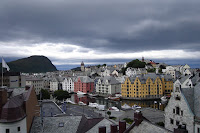
After breakfast, we walked over to the office of the catamaran which offers a tour out to Bunde Island to see if we could get a ticket. The stormy weather has caused them to cancel their scheduled Wednesday afternoon trip. We are dissapointed, but may take a ferry out to the island tomorrow.

In order to scout out the city better, we took the city train tour. It winds its way through the various areas of the city, pointing out the important historical and architectural sights. Then it heads up to a scenic viewpoint on a hill above the city, where it stops for a few minutes for travelers to take photos of the city.


Afterward, we took a bus out to the Sunnmore Museum, east of the city. The largest museum north of Bergen and south of Tronso, featuring a combination of an excellent Norwegian boat collection and 18th century buildings, the adventure brought us sun and more (I couldn't resist).
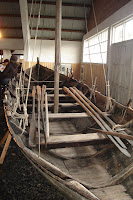

Here is a link to all of the photos we took today: Alesund and Sunnmore
After breakfast, we walked over to the office of the catamaran which offers a tour out to Bunde Island to see if we could get a ticket. The stormy weather has caused them to cancel their scheduled Wednesday afternoon trip. We are dissapointed, but may take a ferry out to the island tomorrow.
In order to scout out the city better, we took the city train tour. It winds its way through the various areas of the city, pointing out the important historical and architectural sights. Then it heads up to a scenic viewpoint on a hill above the city, where it stops for a few minutes for travelers to take photos of the city.

Afterward, we took a bus out to the Sunnmore Museum, east of the city. The largest museum north of Bergen and south of Tronso, featuring a combination of an excellent Norwegian boat collection and 18th century buildings, the adventure brought us sun and more (I couldn't resist).
Here is a link to all of the photos we took today: Alesund and Sunnmore
Subscribe to:
Posts (Atom)